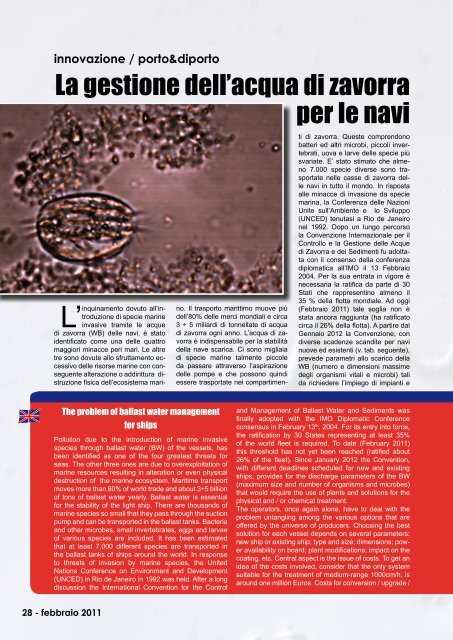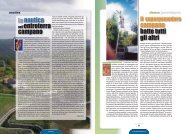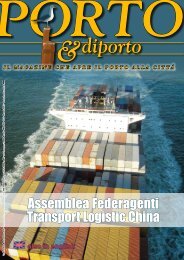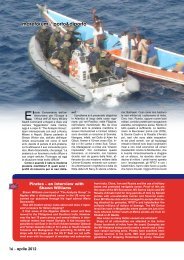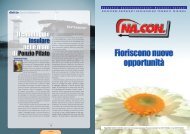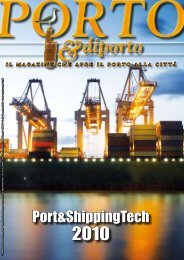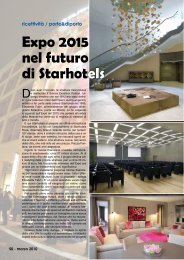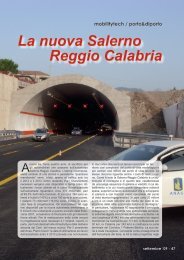You also want an ePaper? Increase the reach of your titles
YUMPU automatically turns print PDFs into web optimized ePapers that Google loves.
innovazione / porto&<strong>diporto</strong>La gestione dell’acqua di zavorraper le navidovuto all’introduzionedi specie marineL’inquinamentoinvasive tramite le acquedi zavorra (WB) delle navi, è statoidentificato come una delle quattromaggiori minacce peri mari. Le altretre sono dovute allo sfruttamento eccessivodelle risorse marine con conseguentealterazione o addirittura distruzionefisica dell’ecosistema marino.Il trasporto marittimo muove piùdell’80% delle merci mondiali e circa3 ÷ 5 miliardi di tonnellate di acquadi zavorra ogni anno. L’acqua di zavorraè indispensabile per la stabilitàdella nave scarica. Ci sono migliaiadi specie marine talmente piccoleda passare attraverso l’aspirazionedelle pompe e che possono quindiessere trasportate nei compartimentidi zavorra. Queste comprendonobatteri ed altri microbi, piccoli invertebrati,uova e larve delle specie piùsvariate. E’ stato stimato che almeno7.000 specie diverse sono trasportatenelle casse di zavorra dellenavi in tutto il mondo. In rispostaalle minacce di invasione da speciemarina, la Conferenza delle NazioniUnite sull’Ambiente e lo Sviluppo(UNCED) tenutasi a Rio de Janeironel 1992. Dopo un lungo percorsola Convenzione Internazionale per ilControllo e la Gestione delle Acquedi Zavorra e dei Sedimenti fu adottatacon il consenso della conferenzadiplomatica all’IMO il 13 Febbraio2004. Per la sua entrata in vigore ènecessaria la ratifica da parte di 30Stati che rappresentino almeno il35 % della flotta mondiale. Ad oggi(Febbraio 2011) tale soglia non èstata ancora raggiunta (ha ratificatocirca il 26% della flotta). A partire dalGennaio 2012 la Convenzione, condiverse scadenze scandite per navinuove ed esistenti (v. tab. seguente),prevede parametri allo scarico dellaWB (numero e dimensioni massimedegli organismi vitali e microbi) talida richiedere l’impiego di impianti eThe problem of ballast water managementfor shipsPollution due to the introduction of marine invasivespecies through ballast water (BW) of the vessels, hasbeen identified as one of the four greatest threats forseas. The other three ones are due to overexploitation ofmarine resources resulting in alteration or even physicaldestruction of the marine ecosystem. Maritime transportmoves more than 80% of world trade and about 3÷5 billionof tons of ballast water yearly. Ballast water is essentialfor the stability of the light ship. There are thousands ofmarine species so small that they pass through the suctionpump and can be transported in the ballast tanks. Bacteriaand other microbes, small invertebrates, eggs and larvaeof various species are included. It has been estimatedthat at least 7,000 different species are transported inthe ballast tanks of ships around the world. In responseto threats of invasion by marine species, the UnitedNations Conference on Environment and Development(UNCED) in Rio de Janeiro in 1992 was held. After a longdiscussion the International Convention for the Controland Management of Ballast Water and Sediments wasfinally adopted with the IMO Diplomatic Conferenceconsensus in February 13 th , 2004. For its entry into force,the ratification by 30 States representing at least 35%of the world fleet is required. To date (February 2011)this threshold has not yet been reached (ratified about26% of the fleet). Since January 2012 the Convention,with different deadlines scheduled for new and existingships, provides for the discharge parameters of the BW(maximum size and number of organisms and microbes)that would require the use of plants and solutions for thephysical and / or chemical treatment.The operators, once again alone, have to deal with theproblem untangling among the various options that areoffered by the universe of producers. Choosing the bestsolution for each vessel depends on several parameters:new ship or existing ship; type and size; dimensions; poweravailability on board; plant modifications; impact on thecoating, etc. Central aspect is the issue of costs. To get anidea of the costs involved, consider that the only systemsuitable for the treatment of medium-range 1000cm/h, isaround one million Euros. Costs for conversion / upgrade /28 - <strong>febbraio</strong> 2011


